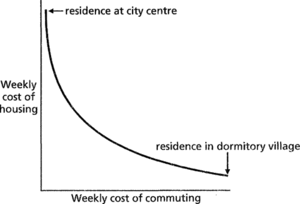A contour line for a utility function. Since all points give the same value of the utility function, there is no reason to prefer one of the points on the indifference curve to any other.
In economics, a graph of the various levels of utility achieved at different prices through buying two commodities or services, for example, a mortgage and commuting costs. At a given price, various combinations of the two would yield the same total utility, hence the term ‘indifference’. The concept is used in the Alonso model, and the monocentric city model; see Bertaud and Brückner (2005) Reg. Sci. & Urb. Econ. 35, 2.

Indifference curve
A graphical representation of the set of commodity bundles that are ranked as equally good by a consumer. If commodity bundles x and y are on the same indifference curve then the consumer is indifferent between x and y; and for any utility function representing the consumer’s preferences U(x) = U(y).
The indifference curves representing transitive and non-satiated preferences cannot cross. The slope of an indifference curve at any point shows the marginal rate of substitution between the goods, and the elasticity of substitution measures its curvature. Assume the consumer prefers more of every good to less. Then commodity bundles above an indifference curve are preferred to those on it, and these are preferred to those below. The indifference curve will also be downward-sloping. Indifference curves are convex to the origin if the consumer prefers variety (some amount of every good) to either good alone, but this is not a logical necessity. If it is assumed instead that the consumer prefers less of one of the goods, for example labour, then the indifference curves slope upwards. See also community indifference curve.